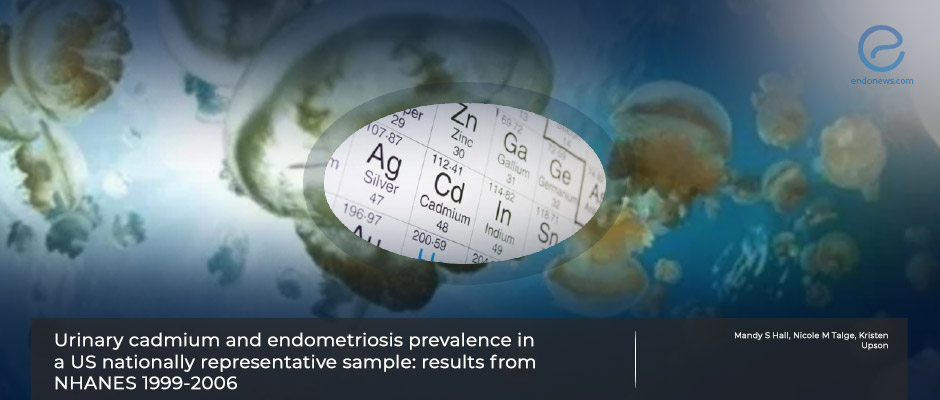Toxic metal cadmium and Endometriosis
Sep 5, 2023
The ubiquitous environmental contaminant cadmium interferes with estrogen hormone
Key Points
Highlights:
- Cadmium is a well-known toxic environmental contaminant with a capacity of estrogenic properties.
- Cadmium released via industrial processes is absorbed by plants, including tobacco, leafy vegetables, root vegetables, grains, soybeans, and by aquatic organisms, such as shellfish.
Importance:
-
Due to its inefficient excretion, cadmium accumulates in the kidneys with a long biological half-life in the human body.
What's done here:
- The study investigated the association between urinary cadmium and endometriosis prevalence using a nationally representative sample of the US population.
- A cross-sectional study using data from the National Health and Nutrition Examination Survey across four data cycles involving 41.474 participants.
Key Results:
- The geometric mean and distribution of urinary cadmium concentrations were slightly higher for participants with a history of endometriosis.
- There was a 60% increased prevalence of endometriosis with urinary cadmium concentrations in the fourth quartile versus the first quartile.
Limitations of the study:
- It is possible that the observed association between urinary cadmium and endometriosis prevalence may be confounded by other co-occurring conditions.
- Additionally, endometriosis may co-occur with other gynecological conditions such as polycystic ovary syndrome, infertility, adenomyosis, and pregnancy loss, which may also be associated with exposure to cadmium.
Lay Summary
Data analyst Mandy Hall and and colleagues from the Department of Epidemiology and Biostatistics, Michigan State University, USA, have published their results on cadmium levels and endometriosis in a recent issue of “Human Reproduction”.
In 2020 the World Health Organization placed cadmium in the top 10 chemicals of public health concern. Cadmium released from industrial sources to the environment is absorbed by plants, including tobacco, leafy vegetables, root vegetables, grains, soybeans, and by aquatic organisms, such as shellfish. Moreover, cigarette smoke is another important source of cadmium. Since the excretion of cadmium is inefficient in the human body, it readily accumulates in the kidneys with a long biological half-life. Cadmium can bind to estrogen receptors and also has been shown to increase endometrial proliferation in in vitro and in vivo studies. However, earlier epidemiologic studies investigating cadmium and endometriosis have yielded confusing results.
This study investigated the association between urinary cadmium and endometriosis prevalence using a nationally representative sample of the US population. A cross-sectional study using data from the National Health and Nutrition Examination Survey (NHANES) across four data cycles between 1999 and 2006 involving 41.474 participants was made.
Data revealed that urinary cadmium was associated with an increased prevalence of endometriosis. The geometric mean and distribution of urinary cadmium concentrations were slightly higher for participants with a history of endometriosis (0.30 lg/g, 95% CI: 0.27–0.34) than participants without such a history (0.25 lg/g, 95% CI: 0.2-0.26). There was a 60% increased prevalence of endometriosis with urinary cadmium concentrations in the fourth quartile versus the first quartile (PR 1.6, 95% CI: 0.8, 3.2).
However, this epidemiological study has some limitations. Given the cross-sectional study design, urinary cadmium concentrations and history of endometriosis diagnosis were both ascertained at the time of National Health and Nutrition Examination Survey, (NHANES) participation. However, urinary cadmium characterizes long-term exposure over the past 10–30 years due to the long elimination half-life from the kidneys. However, it is possible that the observed association between urinary cadmium and endometriosis prevalence may be confounded by another co-occurring gynecological condition, leiomyoma uteri. Furthermore, endometriosis may co-occur with other gynecological conditions such as polycystic ovary syndrome, infertility, adenomyosis, and pregnancy loss, which may also be associated with exposure to cadmium.
The authors conclude that their results are suggestive that long-term exposure to cadmium is associated with an increased prevalence of endometriosis. Given the substantial morbidity conferred by endometriosis and the exposure of the general population to cadmium, further research is worth confirming these findings.
Research Source: https://pubmed.ncbi.nlm.nih.gov/37487110/
endometriosis cadmium epidemiology environmental health cross-sectional study

